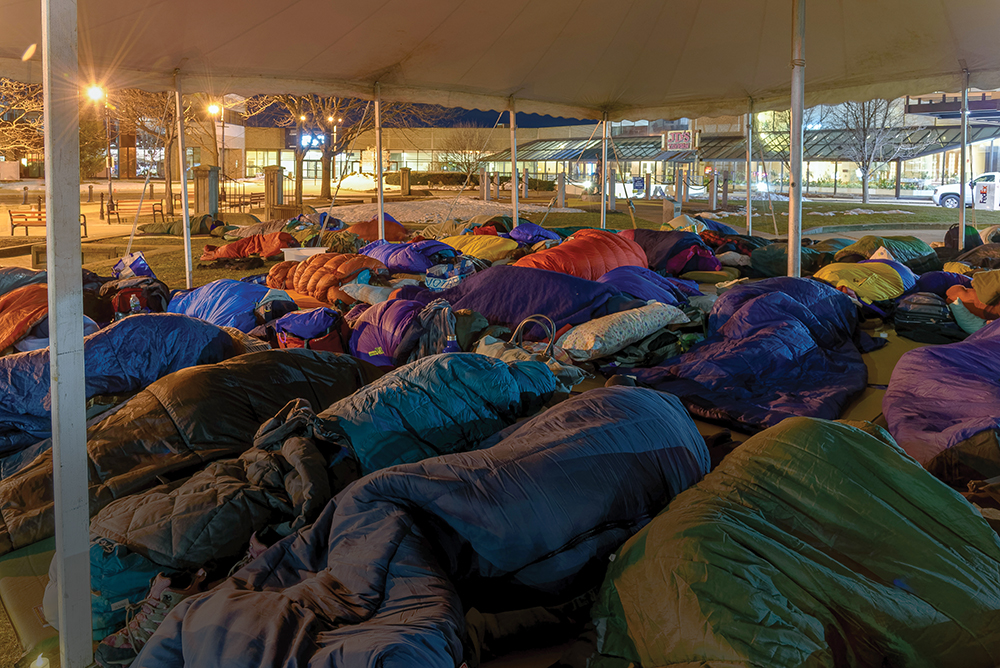 Sleepers under open air tent during Waypoint’s SleepOut event in 2019, which raises awareness and funds to confront youth homelessness in NH. (Courtesy of Waypoint)
Sleepers under open air tent during Waypoint’s SleepOut event in 2019, which raises awareness and funds to confront youth homelessness in NH. (Courtesy of Waypoint)
Editor’s note: This article is part of a continuing series of stories examining homelessness in NH.
With the arrival of summer, many teenagers are looking forward to high school graduations, summer fun and jobs. But for thousands of young people in the state, their only goal is to survive another day. An estimated 15,000 youth experienced some form of homelessness in NH in 2022, according to Chapin Hall, a policy research institution at the University of Chicago focusing on child welfare and family well-being. And at least 70% of them will not have the option to return home. Children represented 19% of those staying at state-sponsored shelters in NH in 2019.
Taylor Neal of Littleton is among those teenagers who faced homelessness as a teenager after giving birth to a daughter when she was 19 and not knowing where to turn for help. She was able to connect with Waypoint, which provides a variety of support services, including a pregnancy and parenting program.
For Neal, now 23, the struggle to stay focused on herself and her children’s needs—to find the bandwidth to stay on top of paperwork and her own emotional needs—continues. Still, she feels fortunate to have received help from Waypoint’s Teen Parenting and Pregnancy Program, along with the program’s Care Coordinator Patrice Endres. Neal says the services and support she receives are making the difference between being homeless and having the meaning and hope she says are necessary to raise her children, take care of herself and hopefully break the cycle of intergenerational poverty.
Neal, who has found a home and received services and support, considers herself fortunate. Endres says a lack of services and shelters for young people at risk of homelessness makes outreach difficult in underserved rural parts of the state. While multiple drop-in centers exist, there are currently only two shelters in NH— in Claremont and Manchester—dedicated to young people. Manchester has the only overnight emergency shelter available in the state, and Waypoint Director Erin George-Kelly says there is need for more.
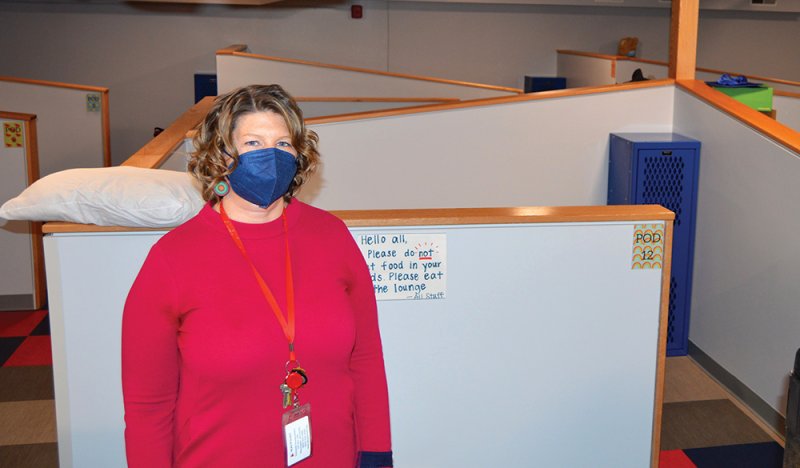
Waypoint Director Erin George-Kelly at the low-barrier shelter in Manchester, serving young adults in need. (Scott Merrill)
In October, Waypoint opened a drop-in resource center in Rochester that offers a food pantry, a clothing closet, laundry, showers, snacks, lockers and an area to gather for activities like watching television, board games, arts and crafts, or to use computers and meet with staff.
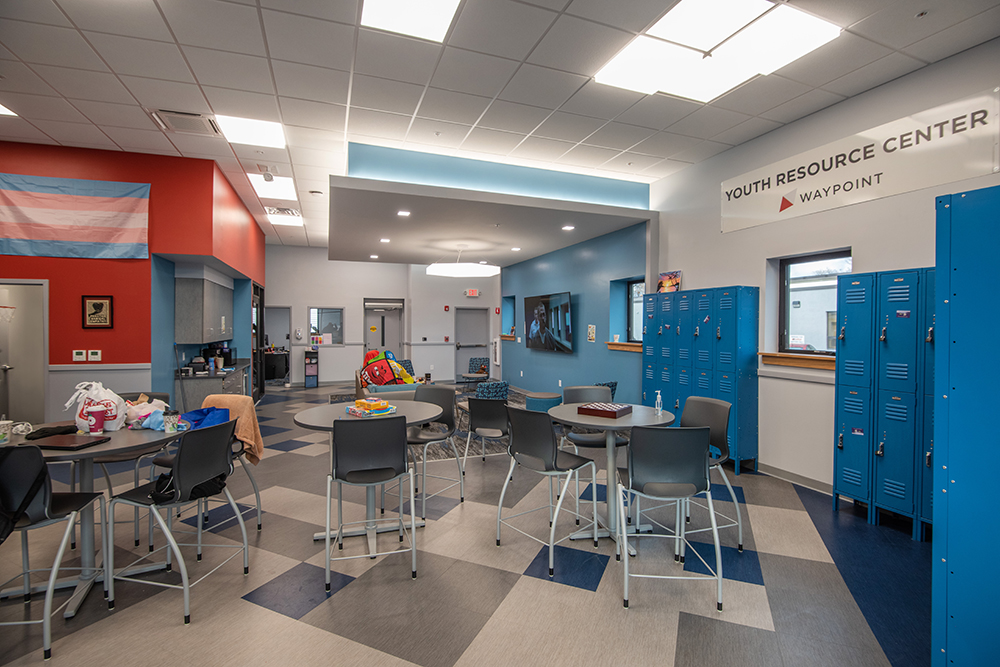
Waypoint’s Youth Resource Center. (Studio One Photography)
Stepping Stones, which provides a drop-in center in Nashua where young people facing homelessness can receive support services, hopes to include emergency shelter beds soon, says Zach Paone, development and communications coordinator.
According to Stepping Stones, there are anywhere between 400 and 800 homeless, unaccompanied young people in the Greater Nashua area on any given night. In 2021, the 211 crisis line received more than 100 calls from young people under 25 requesting emergency shelter in Nashua alone.
Paone says Stepping Stones is the only drop-in center for homeless youth in the greater Nashua area and that his organization works with Waypoint to provide rides to Manchester’s shelter on weekends.
“We’re currently trying to reallocate two of our rooms in the drop-in center for a shelter, hopefully in the next couple of months,” Paone says, explaining that progress young people make during the day, like finding jobs or completing GEDs, “can fall apart quickly when their time at a shelter is up.”
“That’s why we’re devoting all our fundraising resources for our housing program—which starts as an emergency shelter and moves into transitional housing—until people are self-sufficient enough to move out on their own.”
Paone says there are other shelters for adults in the Nashua area that young people could use but these situations often don’t work out. “Kids, youth, aren’t always ready to be thrust into a situation with strangers and wide age ranges,” he says, citing instances where youth staying in adult shelters sometimes feel targeted and fear violent situations. “They need people they can trust so they know the progress they make during the day is worth it.”
Risk Factors for Homelessness
While the reasons for homelessness among young people vary, George-Kelly says data show trends that have emerged in recent years. “Those identifying as LGBTQ+ are four times more likely than their peers to experience homelessness,” she says, adding that intergenerational poverty is another issue. “Many of these young people have been homeless with a parent before becoming a young adult and experiencing homelessness on their own.”
Pregnant and parenting youth are at a 200% higher risk of reporting homelessness when compared to their peers, according to Chapin Hall’s “Missed Opportunities” report. The risk of homelessness is also higher in underserved rural parts of the state where there is a lack of preventative and early intervention services, according to the report.
Other risk factors for homelessness include child welfare and juvenile justice system involvement and lack of a high school diploma or GED. Neal’s care coordinator, Endres, points out that the skyrocketing cost of available housing also puts people at risk of homelessness. Currently there is a 0.5% vacancy rate in the state for two-bedroom apartments with a median cost of $1,584 per month, according to data from the NH Housing Finance Authority. To afford the statewide median cost of a typical two-bedroom apartment with utilities, a NH renter would have to earn 131% of the estimated statewide median renter income, or over $63,000 a year, according to NHHFA.
Another risk factor in homelessness is substance addiction, Endres says, pointing to the opioid epidemic as a major factor exacerbating homelessness and housing instability in the North Country and around the state. She says a lot of the youth she serves are the children of those dealing with substance use and cycles of financial instability, and that she works hard to break this cycle.
“The opioid epidemic hit hard and took people by surprise. And because there weren’t a ton of resources, families really fell apart,” Endres says, adding that the economy is also making it difficult to help young people find a safe, stable and permanent housing option. “There’s not a lot of availability of apartments, and the pay scale isn’t high enough to meet people’s needs even when they work really hard.”
Luckily, Endres says, there are some subsidized housing developments Waypoint can use, but she adds that prior arrests and evictions can make this difficult. “It’s hard when they’ve done all they can and housing is out of reach,” she says. “There are jobs out there. It’s not the working, it’s the ability to afford housing. And on top of this, people need the ability to have transportation. It’s remarkable sometimes they do as well as they do.”
George-Kelly says young people experience a range of housing instability. Most homeless youth in the 12 to 17 age range are couch surfing and spend some time at home. “Some are literally homeless and sleep at Waypoint’s shelter or another shelter, or in their car. Some people are sleeping on couches or floors.”
Independence Takes Support
Endres points out that young people facing homelessness and other struggles in the North Country often don’t have the same supports that exist in places like Manchester. “For the North Country overall, youth experiencing homelessness are more hidden,” she says. “They’re not out in the park or in tents, they’re often staying in someone’s barn or in a basement.”
And many kids, she says, remain isolated out of fear of being placed in foster care. “Young people often don’t want to go into the foster-care system, so they avoid reaching for help.”
George-Kelly adds that young people are also affected by substance misuse and mental illness. “Sometimes this is their own, and sometimes it’s their parent or caregivers,” she says, explaining that many young people who have experienced abuse and neglect at home are on the fringe of homelessness. “They grow up in family systems that are dysfunctional and have multiple contacts with Child Protective Services as minors but never reach the legal threshold to place them in foster care. But when they become 15 to 17, they may decide they don’t want to be there.”
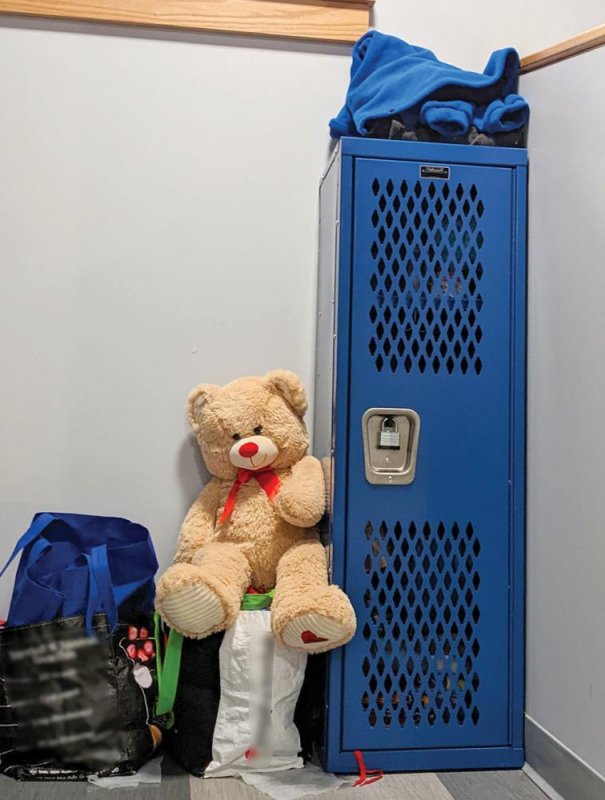
A teddy bear sits within the belongings of a young person staying at Waypoint’s overnight emergency shelter. (Courtesy of Waypoint)
More Data and Coordination Needed
The NH Youth Success Project (YSP) is one of many Youth Action Boards that exist across the country. These are boards of young people who have experienced unaccompanied homelessness (without a parent or guardian) under age 25. New Hampshire’s Youth Action Board launched in March 2020 and was created in partnership with leaders from NH’s three Continuums of Care (CoC), according to NH’s YSP Director Ariel Hayes. (CoCs are collections of agencies, nonprofits and other organizations working together in a particular area to make sure disadvantaged people can access programs and services. They are also the funneling mechanism for HUD’s homelessness grant.)
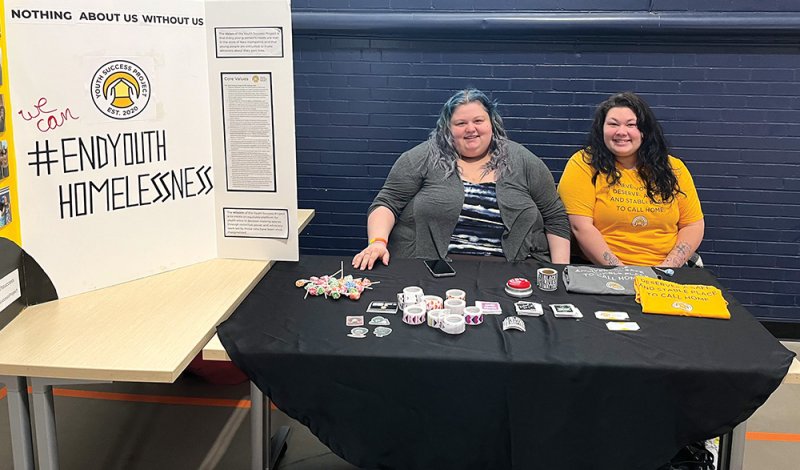
NH Youth Success Project leaders Maddie and Brie spreading awareness about youth and young adult homelessness.(Courtesy photo)
Hayes says the YSP relied heavily on data from Chapin Hall, a national-level policy and research institution, in the development of its 2022 Coordinated Community Plan. Through this process they learned that youth in rural areas experience homelessness at the same rate as youth in urban areas and that, in NH specifically, there are higher risk factors in rural areas and services are far fewer. One of NH’s CoCs ran a pilot survey of youth experiencing homelessness in October of 2021 and found that 54.8% of respondents reported that they were not attending school regularly and had not earned their high school diploma or GED. Chapin Hall research has shown that not having a high school diploma or GED presents a 346% higher risk of youth and young adults experiencing homelessness.
In 2022, YSP utilized funding from a HUD grant as well as the NH Charitable Foundation to run a statewide Youth Count Survey. This survey reached 1,476 young people across NH who provided insight on their experiences leading up to and while homeless.
The study found 46% of respondents were unstably housed (including couch surfing) and 8% were unsheltered. Of the total surveyed, 45% reported struggling with mental health at least half the time and two out of five respondents (40%) reported engaging in survival sex (sex for money, food or shelter). Thirteen percent of respondents indicated they have no adult to turn to, and 61% reported being removed from the home by the Dept. of Children, Youth, and Families (DCYF).
Hayes says available data on homelessness in NH undercounts everyone but especially young people who may be couch surfing or staying with friends or families, or who are laying low in their cars.
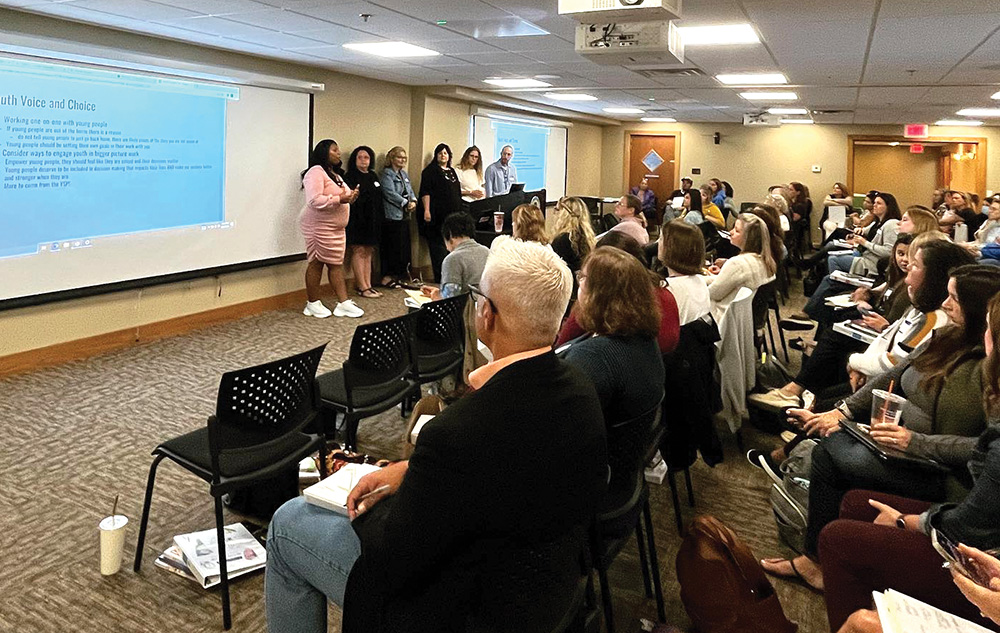
Kadyja Harris, Co-Director of the YSP, presents to McKinney Vento Liaisons across the state at their yearly meeting. (Courtesy of NH Youth Success Project)
“Youth homelessness is usually not super visible,” she says, explaining that it can be hard to count. Every program that receives federal funding must enter their data into the Homelessness Management Information System that is used by HUD. Hayes says, “Not every homeless-serving program operating in New Hampshire has that funding requirement and the system is really finicky, so they tend not to enter people if they don’t have to.”
And this can present a problem, she says, adding that YSP has relied on data from national entities like Chapin Hall. “It is a systems problem,” Hayes says. “The data that we have collected through the New Hampshire Youth Count has been invaluable and is already informing some of the ways we think about youth and young adult homelessness in our state.”
More to be Done
Waypoint, which has regional sites around the state, provides a full continuum of care that includes helping young people find jobs, transitional living, providing an emergency shelter space at its Manchester location, food pantries and community outreach, as well as a rapid rehousing program for those who are highest at risk of dying on the streets.
George-Kelly says work on the state level has extended the age for foster care, which has helped prevent homelessness, but that more needs to be done. “There has been some work on the state level to expand programing for young people, 18- to 21-year-olds who would previously hit 18 and age out of the system and have no place to go,” she says, adding that some services exist for some young people up to the age of 23. “But these programs have only started in the last couple of years.”
While George-Kelly acknowledges these programs may provide benefits down the line, she points to national statistics for those leaving the system as an example of more work needing to be done.
Nationally, approximately 25% of former foster care youth experience homelessness within four years of leaving the system, she says. And nationally, an estimated 550,000 unaccompanied youth and young adults up to age 24 experience a homeless episode of longer than one week over the course of a year, according to the National Alliance to End Homelessness.
And trauma, she adds, is the thread that ties every one of these young people together. “All of the youth we see has some sort of history of trauma and many have complex trauma,” George-Kelly says, explaining that young people often wish to avoid adult shelters out of fear of abuse. What young people need, she and other homeless advocates say, is a safe place where they can focus on basic hygiene and prepare themselves for school or work.
One new program George-Kelly has hope for is a host-home project for 18- to 24-year-olds that would provide places to live. “We’re trying to recruit families in the area who might have an extra bed or a bedroom for homeless young adults. We don’t always need to have staffed emergency shelters where we pack as many people in as possible,” she says, adding that Waypoint’s youth navigation program is also a helpful way for young people experiencing homelessness to learn about various programs and to navigate the system. “Understanding the system is complicated, and when people are in crises, they often don’t have the ability to make five phone calls about where to stay. This provides one point of contact to find appropriate services.”
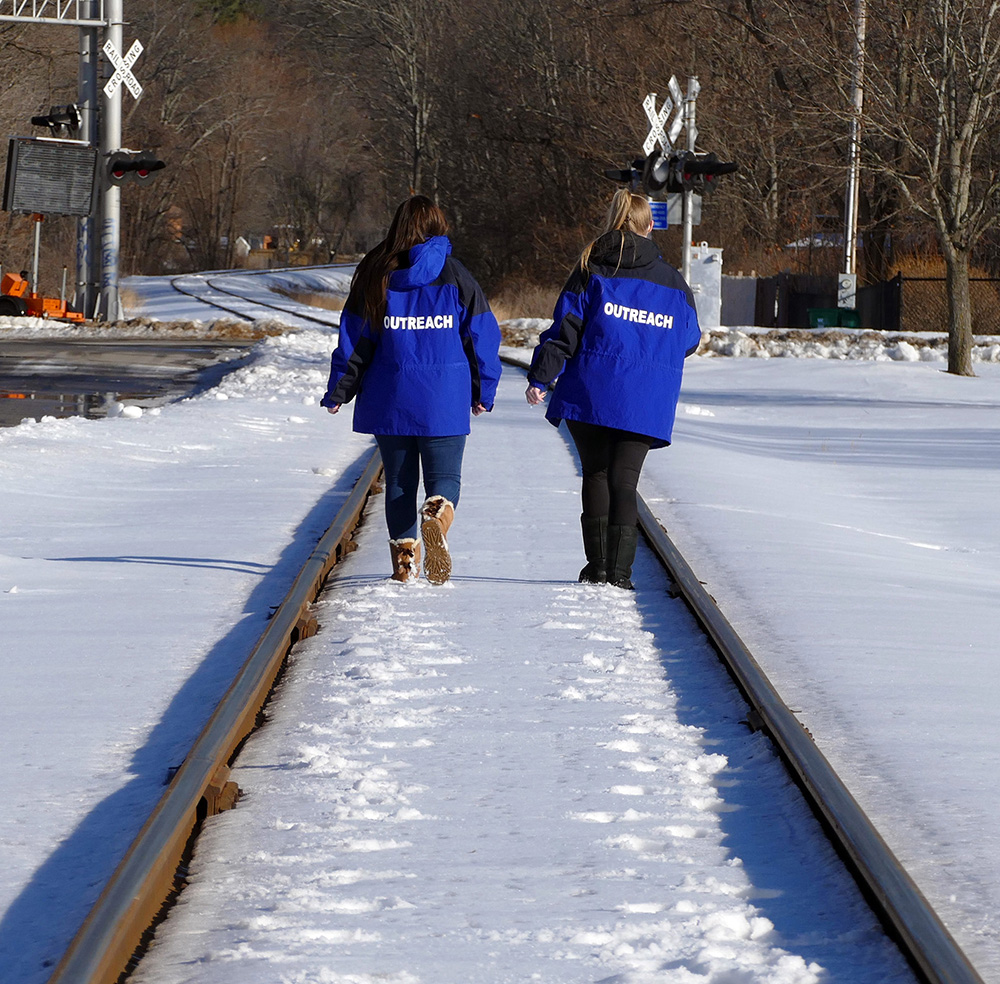
Waypoint outreach workers walk the railroad tracks in Rochester in search of youth at risk. (Courtesy of Waypoint)
Many Barriers Remain
The Waypoint parenting program that helped Neal with interview skills and parenting in Littleton is one of two in the state (the other is in Manchester). Endres says in the North Country, unlike in Manchester or Concord, there are few gathering places and no shelters for young people to form community. She says a lack of services for young people at risk of homelessness can make outreach difficult. “The resources for young homeless people in rural communities are few,” she says, adding that there is community support. “People do come together to help them, and this makes up for [the lack of] professional support and services. There’s a little more trust, maybe.”
The parenting program in Littleton serves three to six families each year and is funded through grants from HUD, the Dept. of Health and Human Services Runaway and Homeless Youth program, and a variety of other sources. “We put it all together and try to make the best with what we have,” she says.
One of the barriers for young parents facing homelessness is child care, Endres says. “It’s a big barrier for young parents. It’s expensive, and it’s hard to find.”
Endres, who has been working at Waypoint for 13 years, says support is vital to helping young people succeed. “When given some support and safety, it can impact long-term outcomes for [young parents] and their children,” she says. “These teens have so much to offer. They are so honest in so many ways. But they need support and guidance and safety to take the next step in their lives.”

 Current Issue - April 2024
Current Issue - April 2024